Updatetime:2024-06-16 11:30:03 View:
When choosing a pillow, first consider your personal sleeping position and preferences. Back sleepers generally benefit from a lower, softer pillow, side sleepers will need a taller, firmer pillow to support their head and neck, and stomach sleepers may prefer a lower, softer pillow. . If you're not sure about your sleeping position, try pillows of different heights and firmnesses to find the one that works best for you.
The pillow material determines the pillow's breathability, elasticity, support, warmth and other characteristics. Common pillow materials on the market include memory foam, latex, buckwheat shell, down, polyester fiber, PE hose, wool, etc. Each material has its advantages and disadvantages, and you need to choose according to your needs and budget.

Memory foam is currently the most comfortable pillow material. It can automatically adjust its shape according to body temperature and pressure, fit the head and neck curve, and provide optimal support and pressure relief. Memory foam also comes in different densities and hardnesses, so you can choose the style that suits you. The disadvantages of memory foam are that it is not breathable, easily generates heat, and is more expensive.
Latex is a material made of natural rubber juice that has been foamed and has good elasticity, support and durability. Latex is also divided into natural and artificial. Natural latex is more environmentally friendly, antibacterial, and anti-mite, but it is also more expensive. The disadvantages of latex are its heavy weight and inconvenience to clean.
Down is an animal hair material that has good fluffiness and softness, good air permeability, and is not easily deformed. Down pillows are suitable for people who like a soft sleeping feel, and they also have a certain degree of warmth. The disadvantages of down pillows are that they can easily cause allergies, are difficult to clean, and are more expensive.
Polyester fiber is a man-made fiber material that is lightweight, cheap, and easy to clean. Polyester pillows are great for those on a budget and can also be used as a backup pillow. The disadvantages of polyester fiber pillows are that they are not breathable, have poor elasticity, and have no auxiliary effect on sleep.
PE hose is a food-grade plastic material that is easy to clean, stain-resistant, and durable. The PE hose pillow can provide fluid support, adjust its shape according to the contour of the head, and remember the head shape. PE hose pillows are also more breathable, hypoallergenic, and not expensive. The disadvantage of PE hose pillows is that they are relatively hard and make a rustling sound.
Wool is an animal hair material with good warmth retention and moisture absorption properties, making it suitable for winter use. Wool pillows are also relatively soft, comfortable, and non-irritating to the skin. The disadvantages of wool pillows are that they can easily cause allergies, are difficult to clean, and are more expensive.

Pillow shape and size can also affect sleep quality and cervical spine health. Generally speaking, pillow shapes can be divided into square, rectangular, butterfly, U-shaped, etc. Each shape has its applicable scenarios and functions.
Square is the most common pillow shape, suitable for various sleeping positions and bed types, and is also easier to match with sheets and quilt covers. There is no special design for square pillows, just choose the appropriate height and hardness.
Rectangular is a relatively long pillow shape, suitable for people who like to roll over or sleep in arms, and can also be used as a cushion. Rectangular pillows can provide more activity space and support area, but you also need to pay attention to whether the height and hardness are appropriate.
The U-shaped is a wrap-around pillow shape, like the letter U. The U-shaped pillow is suitable for people who travel or sleep while sitting. It can fix the head position and prevent it from shaking from side to side. U-shaped pillows are generally made of memory foam or polyester fiber, which are lightweight, soft, and easy to clean. U-shaped pillows can be chosen in different colors and patterns according to personal preferences, and are also more suitable for gift giving.
Pillowcases and pillow covers are parts that directly contact the skin, so you also need to pay attention to choosing the appropriate material and color. The material of pillowcases and pillow covers should be soft, breathable, sweat-absorbent, and antibacterial, such as cotton, linen, silk, etc. Colors should be elegant, fresh, and soothing, such as white, beige, blue, etc. Avoid choosing colors that are too bright, exciting, and dull, such as red, black, purple, etc. Pillowcases and pillow covers should also be replaced and washed regularly to keep them clean and hygienic.
Purchasing a pillow is a decision related to sleep quality and cervical spine health. Comprehensive consideration of personal sleeping position, preferences, needs and other factors, choosing the pillow material, shape, size, pillowcase and pillow cover that suits you can significantly improve your sleeping experience. Hopefully these tips will help you find the ideal pillow and get a good night's sleep every night. For more information about bed pillows, kindly contact us directly.